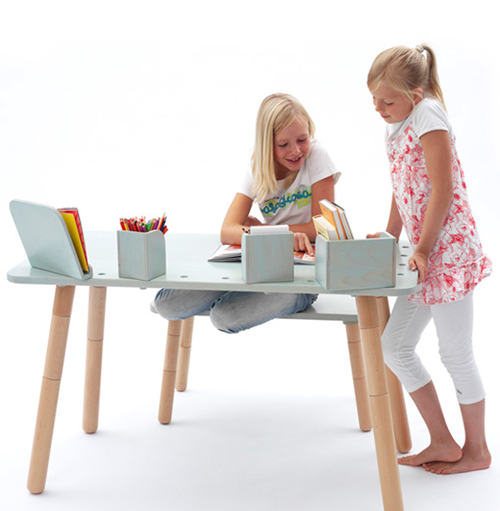Growing table.
a table and stool that grows with your child.
the designer, olaf schroeder designed an innovative product where, quite simply, by adding extensions to the legs of table and stool the furniture “grows” with your child.
adjustable to four heights, growing table is intended for children aged from 2 – 10 and comes with a good selection of accessories; including an “endless paper” system to meet all their doodling wishes.
Specifications:
height: 24.5, 31.5, 37.5 and/ or 44 cm.
material: beech and child safe paint
colors: yellow, orange, pink, water blue, ocean blue or natural
Designer: olaf schroeder
Producer: pure position
Interview with the designer:
ID_OS is a development company for industrial and public design based in Frankfurt am Main. Since 1996, proprietor Olaf Schroeder (*1966) has been developing design concepts and solutions in the fields of product, furniture, system and exhibition design, as well as design projects for public spaces.
Besides the household products he has worked on for manufacturers Hailo, Leifheit and Rowenta, Olaf Schroeder has also developed and designed exhibitions and pavilion architectures. In 2003, Olaf Schroeder was awarded the state of Hesse’s special environmental award for his development work in connection with a solar-powered boat project. From 1998 until 2002, he was a lecturer at Offenbach University of Art and Design.
1. What impact can design have on the sustainability of production conditions?
If you see design as a holistic development process and not just superficial cosmetics, it can have a very considerable influence on how sustainable production conditions are.
2. How sustainable is the sustainability trend?
It’s true that sustainability is a trend right now, or rather a trend word. Braun’s products from the Dieter Rams era were already sustainable long before the term sustainability was ever coined. It was their intelligent functionality and forms that made them sustainable – they were designed to last. But the current sustainability trend is certainly having a positive impact that will take hold in the minds of product developers and consumers alike, to the point where it will become a criteria we take for granted.
3. What can a designer contribute when it comes to Green Design in the furniture sector?
He can contribute in terms of his choice of materials, an economic manufacturing procedure, a high production depth and short supply chains, but above all in terms of form-related criteria based on a long lifecycle rather than short-term trends.
4. What arguments could persuade customers to invest more in quality and consume fewer cheap mass-produced products, which tend to be less durable and more ecologically detrimental?
We’ll probably continue to have both in the future, too: inexpensive mass production on the one hand and highquality products on the other. The consumer knows the difference and decides on one or the other variant depending on the usage context. If we want to get back to less mass production, the system of a globally producing society would have to change entirely. That would also mean abstaining from short-term consumption – I doubt whether our society will shift back to that.
5. What are the aesthetic alternatives to classic (organic) solid wood furniture?
German manufacturers e15 provided some excellent impetus in that respect years ago, and a lot of others are now following in their footsteps.
6. What do you consider an environmental sin and where would you like to see alternative solutions?
Coal-fired power plants can be retrofitted and, in the foreseeable future, even cars will be more eco-friendly than they are now. Progress in the field of alternative energy sources will soon lead to radical changes. The fact that certain nations on this planet are still involved in military conflicts is not only a social catastrophe, it‘s an “environmental sin” as well. If you want to take the ‘sin’ idea further, you could say that, besides the resources wasted by war, the incredible human tragedies it creates are a “sin” of unbearable magnitude.
source : imm cologne 2010



